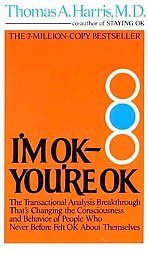|
Communication 101I'm OK, You're OK
I have discovered an effective tool to help two people to understand how their communication is affecting each other and what one can do to get the best results from another without creating defensiveness. From the book "I'm OK, Your OK" written in 1972, by Thomas Harris, I share with couples, a simple formula to analyze their communication with each other. The theory is called Transactional Analysis or T.A.
From this model, every child, growing up, develops three spheres or subparts to their personality. The PARENT, the ADULT, and the CHILD part of us. From the moment we are born, we start recording in the PARENT part of us, "How to do life". Communication comes from our mothers, fathers, siblings, aunts, uncles, extended family, television, movies, where we live, our culture etc. Communication comes from WORDS = 7%, from TONE of voice = 37%, and Body Language and ACTIONS = 56%. Every child is constantly recording "How to do life"; it is a constant stream of information pouring in to their minds. At the same time, the CHILD part of us is recording how it "feels" to be told "How to do life". Many of those feelings are good positive feelings but so many more are recorded as bad feelings. A child, growing up, does not have the vocabulary or understanding of feelings. Only as we reach adulthood do we understand the true nature of fear, shame, jealousy, joy, guilt, loneliness, abandonment, rage, anxiety, hatred, etc. But a child records all those ill feelings as "bad or I'm not OK". The child stores all those bad feelings in a "deep well" of "NOT OK" feelings. The ADULT part of us starts to develop at about age one, when a child starts to move around, express themselves, and starts to develop what they think will work in their own life. They might hear their parents say to them "stop fighting kids!" but have to listen to their parents fighting constantly. This inconsistency is resolved in the ADULT part of us. The ADULT part of us is the rational part that has figured out "What works for me".
Parent ------------------------------------ParentAdult---------------------------------------AdultChild----------------------------------------Child
The best, most productive communication is a horizontal movement across the chart from right to left and from left to right. Two adults discussing what to do about their two year old child would be an example of PARENT to PARENT communication. From an "I'M OK, You're OK attitude, or "I respect me and I respect you", each party is respecting the other in WORDS, TONE of voice and body language or ACTIONS. Any two persons discussing anything in a rational manner, not putting each other down with WORDS, TONE or ACTIONS or using their emotions to emphasize what they are saying would be an example of ADULT to ADULT communication. Two friends or lovers playfully joking with each other would be an example of CHILD to CHILD communication. Guys are notorious for their child to child comments, put downs, and jousting. When done with the understanding that "I'm OK and you're OK", no harm is taken or intended. But if one party perceives a playful put down as a real put down, or a PARENT to CHILD communication, then watch out! Harsh words or a fight ensues. In couple's therapy, I challenge each person to observe their own words, tone of voice and body language to make sure their ADULT to ADULT communication is not PARENT to CHILD. We all have that "deep well" of NOT OK feelings, and when we feel a communication, especially from our spouse, is a put down, then we usually react defensively, either child to parent (by withdrawing, pouting or an emotionally loaded comment back to the other) or a parent to child comment like (you're much worse than I am, "You do this or that...). When anger is used in our communication, it is usually taken as a parent to child put down because they are saying "I'M OK, YOU'RE NOT OK" and you can expect defensiveness and anger to escalate. Every adult wants and expects to be spoken to with respect. We all get the most out of our communications when delivered with respect.

One evening, I was driving home from work and as I was passing the corner of our property, I noticed someone sitting in the bushes under the streetlight. It was dark and I wanted to find out if this person was some kind of threat to my family. I parked my car in the driveway about 50 feet from the man. I had no idea who this was, and I didn't want to tap into his "not OK child", his deep well of "not OK feelings." I sauntered back down the road and in a friendly tone, I said, "How's it going". Like I said, it was dark and I didn't want to cause him to be defensive, and the first thing he would notice was the way I walked toward him...definitely not in an intimidating way. I didn't say in a loud, mean voice, "Hey!" As I approached him he stood up and greeted me with the same tone as I had greeted him. As it turned out, he had walked from a nearby apartment to drink a beer because he was having an argument with his wife. I told him than I understood, and appreciated the fact that he did not cross my property line, which a lot of local high school kids had done in the past. I invited him to come back to that spot in the future if he needed a place to chill out. I walked back to my home, happy to have found out that a neighbor was not a threat to my family and happy to have used 'Transactional Analysis' to get the information I needed without getting a defensive response. When I was 17 years old, my dad was speaking with me about something I had done wrong and I distinctly remember saying to myself, "I wonder when I will finally feel like I'm OK!" I discovered that when I went off to college that I had finally arrived at OK-ness. Adults expect to be treated with respect. When we finally meet our spouse, we especially expect to be treated with respect. Most conflicts can be endured if we feel that our spouse is respecting us. |
Books
